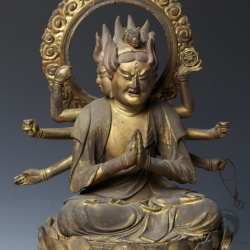Difference between revisions of "Batō Kannon"
| Line 1: | Line 1: | ||
[[File:Bato_kannon.jpg|thumb|250px|]] | [[File:Bato_kannon.jpg|thumb|250px|]] | ||
| − | + | {{Seealso|Hayagriva}} | |
The “[[Horse-Headed Kannon]]” is considered [[Protector of Animals]]. He is the only [[manifestation]] of [[Kannon]] that shows [[rage]]. [[Batō Kannon]] is also one of the the warlike and [[wrathful deities]] of [[Esoteric Buddhism]]; in this role, the [[deity]] is known as [[Batō Myō-ō]]. | The “[[Horse-Headed Kannon]]” is considered [[Protector of Animals]]. He is the only [[manifestation]] of [[Kannon]] that shows [[rage]]. [[Batō Kannon]] is also one of the the warlike and [[wrathful deities]] of [[Esoteric Buddhism]]; in this role, the [[deity]] is known as [[Batō Myō-ō]]. | ||
| Line 8: | Line 8: | ||
Well-known examples dating from the {{Wiki|Kamakura}} period include the [[standing]] [[statues]] in [[Kanzeonji]], [[Joururiji]] and [[Nakayamaji]]. The similarities of our figure to these famous examples suggest it had been made in the area of [[Kyoto]]. | Well-known examples dating from the {{Wiki|Kamakura}} period include the [[standing]] [[statues]] in [[Kanzeonji]], [[Joururiji]] and [[Nakayamaji]]. The similarities of our figure to these famous examples suggest it had been made in the area of [[Kyoto]]. | ||
| − | + | ||
{{R}} | {{R}} | ||
[http://www.giuseppepiva.com/index.php/en/bato-kannon.html www.giuseppepiva.com] | [http://www.giuseppepiva.com/index.php/en/bato-kannon.html www.giuseppepiva.com] | ||
[[Category:Hayagriva]] | [[Category:Hayagriva]] | ||
| + | {{JapaneseTerminology}} | ||
Latest revision as of 09:03, 23 July 2014
- See also :
- See also :
The “Horse-Headed Kannon” is considered Protector of Animals. He is the only manifestation of Kannon that shows rage. Batō Kannon is also one of the the warlike and wrathful deities of Esoteric Buddhism; in this role, the deity is known as Batō Myō-ō.
As typical, Batō Kannon is here depicted capped by the horse head and flame-haired, with three eyes, three heads and eight arms. He expresses anger by his wide open eyes and open mouth. The primary hands make the gesture of bakô-in (“mudra of the horse mouth”), pressing together the palms with the index and ring fingers bent and the rest of his fingers extended). In his other hands he holds a sacred wheel and a rosary, while a staff, a lotus flower and a sword or an ax are missing. The legs on this sculpture are rather unusual, with the lotus position instead of the more common anraku-za (relaxed position). The lotus pedestal mounted over a tall base is of good quality, with petals individually carved, and incorporates a round mandorla carved with clouds.
In the Edo period, Batō came to be worshiped as a protector of horses due to his iconography and his role as saviour of those in the realm of animals. Many remaining stone statues of Batō were once set in place to protect travellers and their horses from injury on dangerous paths.
Well-known examples dating from the Kamakura period include the standing statues in Kanzeonji, Joururiji and Nakayamaji. The similarities of our figure to these famous examples suggest it had been made in the area of Kyoto.
